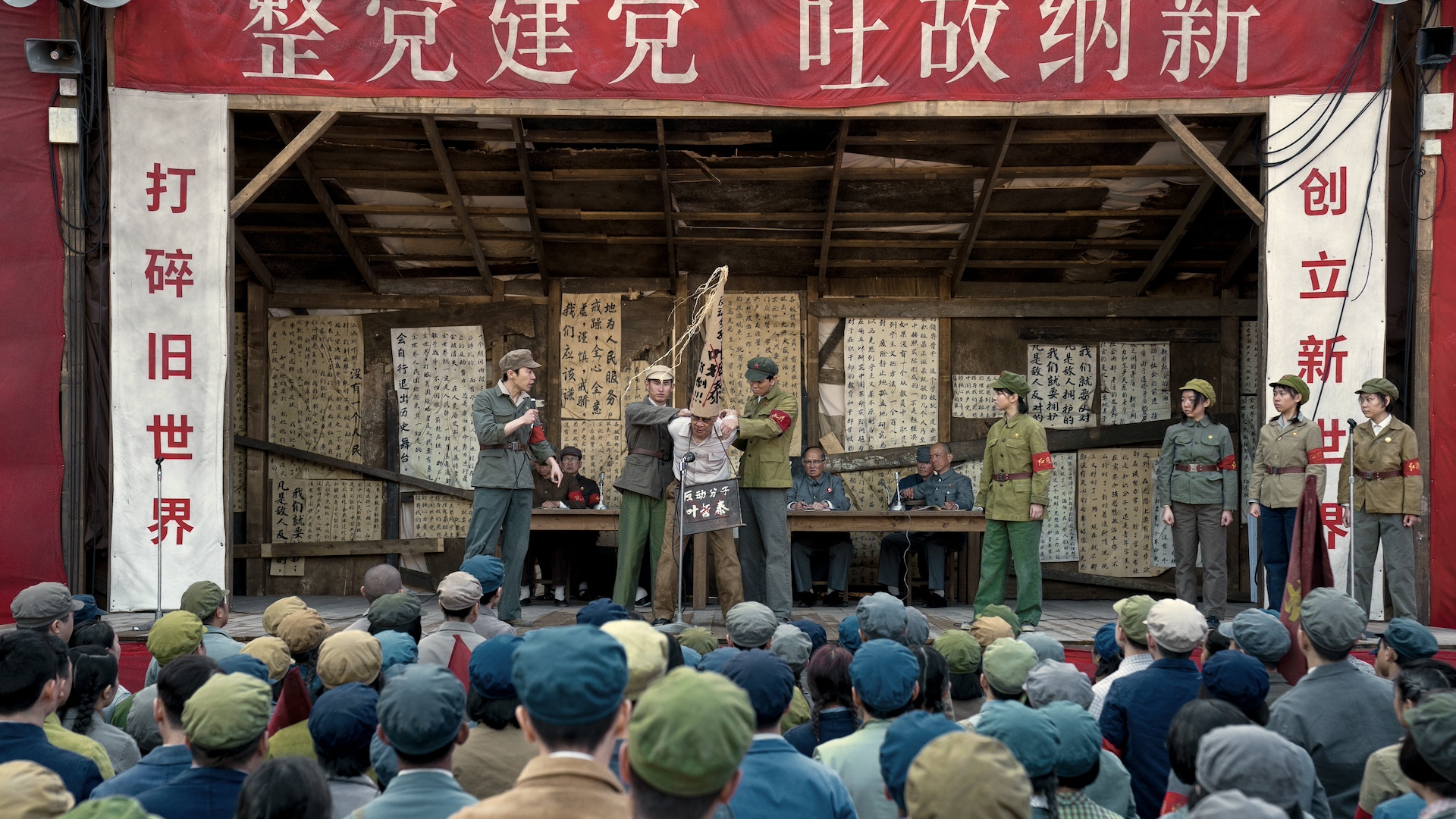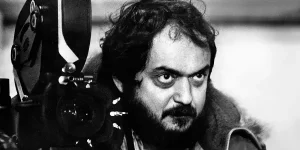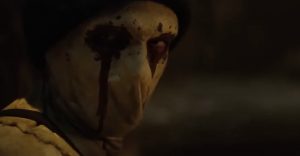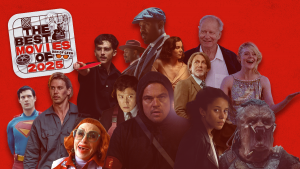
This article contains spoilers for 3 Body Problem episode 1.
Netflix has relentlessly promoted its latest big budget series, 3 Body Problem, as a science fiction epic.
Based on a trilogy of sci-fi novels from Cixin Liu, the show is full of speculative ideas and a storytelling canvas of the known universe. Going into episode 1, viewers have been primed to expect aliens at the very most or some outer space at the very least. Imagine their surprise then when episode 1 “Countdown” opens with the text “Beijing, Tsinghua University, 1966.”
As that text promises, the first five minutes of 3 Body Problem take place in Beijing, 1966 at a revolutionary rally known as a “struggle session.” Through the eyes of the young Ye Wenjie (Zine Tsung) we watch as her peers parade several academics onstage and humiliate them.
“Root out the bugs! Sweep away all monsters and demons!” the teenagers cry as they raise their little red books to the heavens.
One man onstage tearfully confesses he is a counterrevolutionary and tearfully begs to be rehabilitated. When he is carried off, Ye Wenjie’s own father is brought out. A professor of physics, Ye Zhetai is challenged to denounce the theory of relativity as American imperialism. He refuses to refute the science even when his wife is summoned onstage to beg for forgiveness. Ye Wenjie can only watch in horror as the rally gets out of hand and her father is beaten to death.
What viewers witness in this moment is an example of what went down during the Chinese Cultural Revolution. Taking place from 1966 through 1976, the Cultural Revolution was Chairman Mao Zedong’s final attempt to instill lasting communist fervor into Chinese culture and keep his legacy alive long after his death. In some ways, he was successful – Mao remains an important political and historical figure in the People’s Republic of China today. In other ways, however, he was not. Despite still being ruled by the Chinese Communist Party, modern day China is far more capitalist than Mao would have anticipated.
Opening with this historical context not only comes straight from Cixin Liu’s novel but it gives 3 Body Problem a sound narrative foundation upon which to build upon. As some of the show’s characters make destructive decisions in the episodes to come, one must only think back to this prologue for them to all make a little more sense. The show does provide viewers with enough information to appreciate the opening scene as is, but would a better understanding of Chinese history make it even more powerful? We think it would and we’re here to help with that mission.
In the three sections that follow, we will briefly explain the Chinese Revolution of 1911, Mao Zedong’s Great Leap Forward, and the Chinese Cultural Revolution of the 1960s.
But first: a word of warning. This rundown is designed to help you appreciate the historical context of the era and enhance of your enjoyment of 3 Body Problem. It is in no way a scholarly examination of Chinese history. Human history is a big, complex beast that requires years of research and debate to even begin to comprehend. So don’t go telling people that Den of Geek taught you everything you need to know about 20th Century China.
Our sources for the piece include BBC, Vox, John Green’s Crash Course, and Old Faithful herself: Wikipedia.
The 1911 Revolution
To fully understand the Chinese Cultural Revolution of the ’60s we first have to turn to the first Chinese Revolution of 1911. Coming on the heels of the American Revolution and French Revolution (but right before the Russian Revolution), the 1911 Revolution (also known as the Xinhai Revolution or Hsinhai Revolution) marked the end of the Qing Dynasty and the beginning of a post-monarchy era for China.
For all of its recorded history up to that point, China was ruled by monarchial dynastic families. Though these were all distinct dynasties – Tang, Yuan, Ming, Han, etc. – the concept of “the Mandate of Heaven” essentially united all of China under the idea of one singular dynastic rule for four millennia. Things fell apart thanks to two unlikely bedfellows: Chinese nationalists and Chinese communists. Though the nationalist faction and the communist faction didn’t agree on much, they did agree that the Qing Dynasty had to come to an end.
With the help of the disaffected army, the revolutionaries overthrew the Qing dynasty and in its place attempted to create the first Republic of China. That attempt was ultimately not successful. Sun Yat-sen, a unifying figure for both nationalists and communists, deferred executive power to the general Yuan Shikai, who in turn tried to seize empirical power for himself. This led to the collapse of the provisional government and a conflict between the nationalists and communists for control of the country.
From 1927 through 1949, the nationalists and the communists were embroiled in a bitter civil war. The communists were ultimately victorious and Chairman Mao Zedong established the People’s Republic of China in 1949. The nationalists retreated to the island of Taiwan where they established the Republic of China.
Mao Zedong and the Great Leap Forward
It’s one thing to win a war, it’s another thing entirely to govern afterward. Under Mao Zedong the People’s Republic of China enjoyed some initial quality of life improvements by adopting the industrialization strategies of the Soviet Union. Unfortunately, Mao got over his skis and ordered something called The Great Leap Forward in an attempt to quicken China’s industrialization even further.
The Great Leap Forward was a collection of economic policy decisions designed to quickly transition China’s agrarian economy into an industrialized one. Mao Zedong planned to accomplish this by using sheer man power rather than Western machinery and capital expenditure. Small communities were expected to begin developing steel in backyard furnaces in addition to their farming duties. Grain, of which China did not have a surplus, was traded to the Soviet Union in return for heavy machinery.
This large-scale reapplication of farm labor, along with many other inefficiencies and general bad math, eventually led to a famine that killed anywhere between 15 and 55 million people. The program was repealed by 1960.
What Was the Chinese Cultural Revolution?
Realizing that the Great Leap Forward had been a massive failure, an aging Mao sought for a way to return to the good old days of the revolution when patriotic fervor filled the nation and the Chinese people were excited for their dynasty-free future. Ironically, all the death and discomfort of the preceding years provided Mao with a narrow path to do so.
Young people in China were tremendously disillusioned with the state of their country. So Mao began a propaganda campaign to tear down the last vestiges of Imperial China and preserve communist ideology. Via his collections of sayings, quotations, speeches, and writings known as the “Little Red Book,” Mao built up a cult of personality among China’s younger generation. Students across the country were organized into factions known as The Red Guard and held major rallies in universities like the one seen in 3 Body Problem.
The disaffected students reveled in the opportunity to let out their frustration with the bourgeoisie adults in their lives. These struggle session rallies were designed to humiliate professors and sometimes even parents who just couldn’t leave the old world behind. And that “old world’ was indeed a major boogeyman as the Cultural Revolution sought to destroy the “Four Olds” consisting of Old Culture, Old Habits, Old Ideas, Old Customs.
When Mao died in 1976, the Cultural Revolution effectively came to a close. The Gang of Four, a group of Maoist supporters which included Mao’s wife Jiang Qing, was arrested just over a month after the Chairman’s death as China attempted to reform its government into something more stable.
Those 10 years of Cultural Revolution still loom large for many though. And as we’ll come to see throughout 3 Body Problem, they loom particularly large for Ye Wenjie.
All eight episodes of 3 Body Problem are available to stream on Netflix now.
The post 3 Body Problem: The Chinese Cultural Revolution Explained (Briefly) appeared first on Den of Geek.










